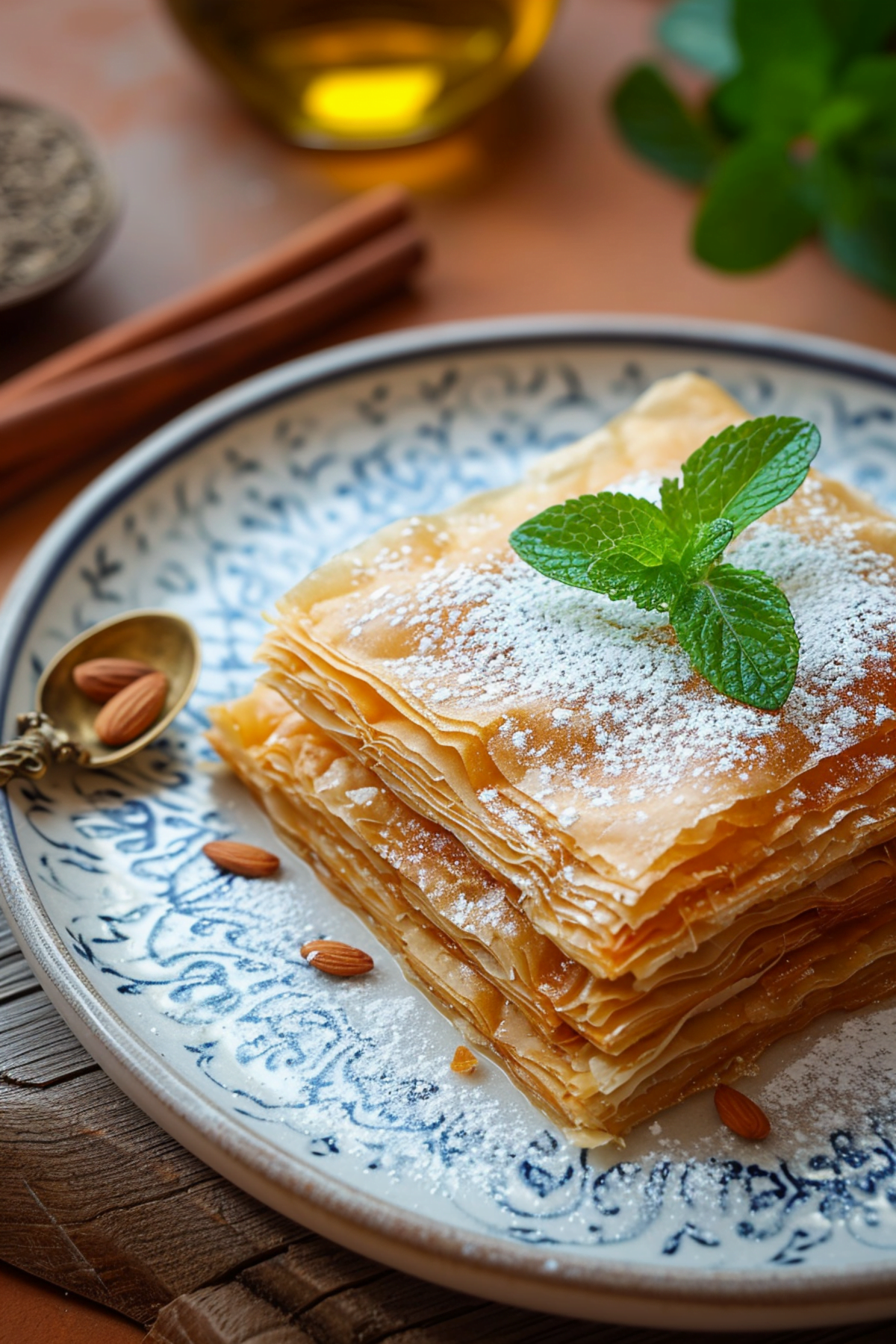Moroccan Bisteeya with Chicken and Cinnamon: A Culinary Journey
Embark on a gastronomic adventure with the rich and complex flavors of Moroccan Bisteeya with Chicken and Cinnamon. This dish is a celebration of textures and tastes, combining the savory goodness of spiced chicken with the delicate sweetness of powdered sugar and almonds, all encased in flaky phyllo pastry. Perfect for a dinner that’s anything but ordinary, this recipe promises to transport your senses straight to the heart of Morocco.
Whether you’re a seasoned chef or a curious foodie, the Bisteeya, also known as pastilla, is a show-stopping entree that’s sure to impress. As you read on, you’ll discover the secrets to creating this traditional Moroccan delight, along with variations and substitutions to tailor it to your taste. Prepare to dazzle your dinner guests with a dish that’s as visually stunning as it is delicious.
So, let’s get ready to infuse your kitchen with the aromatic spices and sweet scents of Morocco. By the end of this journey, you’ll have mastered the art of making a truly authentic Moroccan Bisteeya with Chicken and Cinnamon.
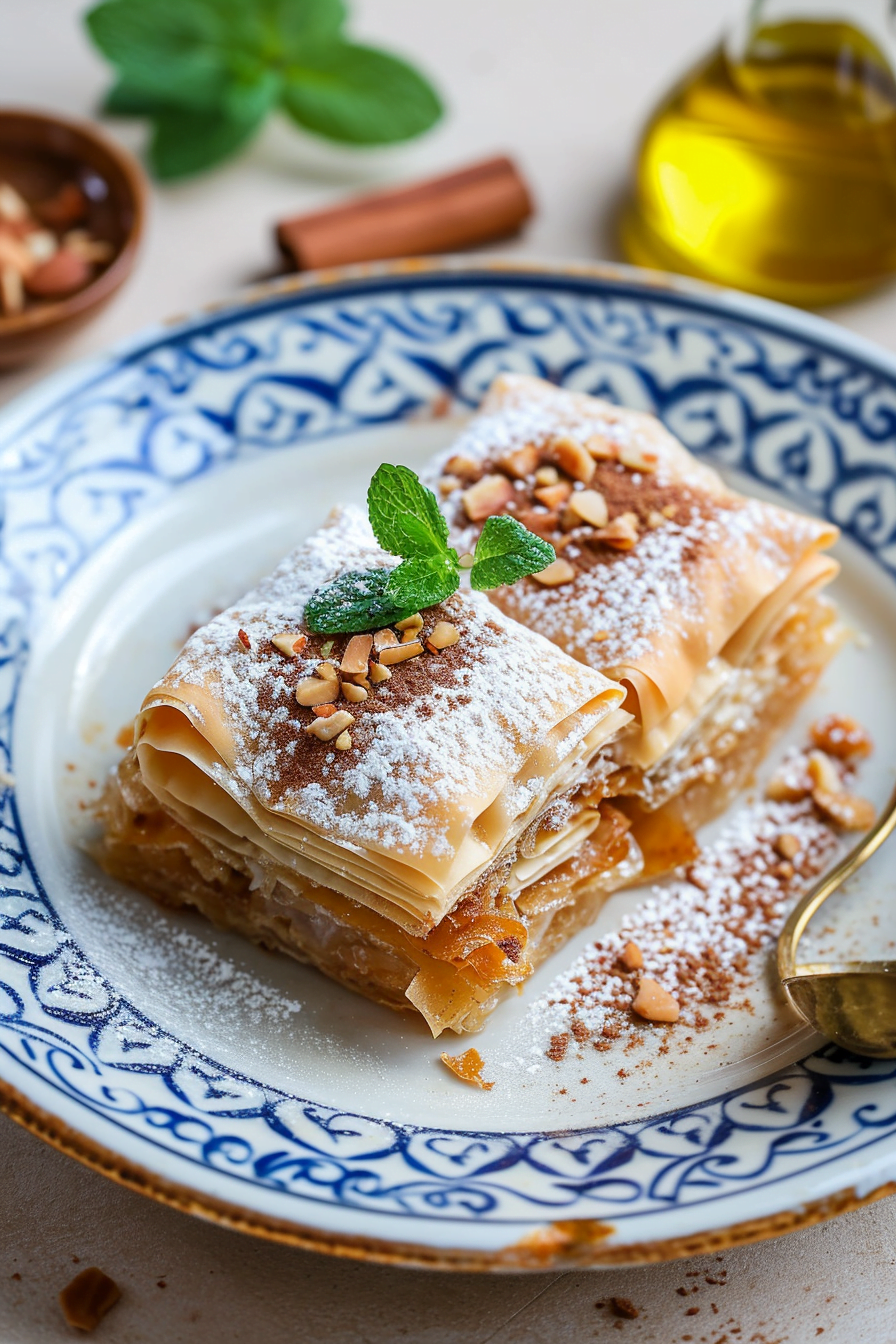
The Essence of Moroccan Bisteeya
The Moroccan Bisteeya is a dish steeped in history, originating from the cultural crossroads of Andalusia and the Maghreb. This savory pie is a staple at celebrations and family gatherings, showcasing the intricate layering of flavors that Moroccan cuisine is known for. The Bisteeya is a testament to the country’s culinary diversity, blending Arab, Berber, and even Spanish influences into a single, harmonious dish.
Traditionally, Bisteeya is prepared with pigeon, but chicken has become a popular and accessible alternative. The use of cinnamon in this recipe is not merely for flavor; it’s a nod to Morocco’s role in the historic spice trade, where spices like cinnamon were as valuable as gold. The combination of sweet and savory elements reflects the complexity of Moroccan palates, where spices are used to create depth rather than just heat.
The Bisteeya is a celebration of contrasts: the crisp, golden layers of phyllo dough against the tender, spiced chicken; the sweetness of powdered sugar balanced by the savory filling. Every bite is a mosaic of textures and tastes that tell a story of Morocco’s rich cultural tapestry. This dish is a labor of love, a culinary ritual that pays homage to the country’s storied past and vibrant present.
As we delve into the preparation of this beloved Moroccan specialty, remember that cooking is as much about the journey as it is about the destination. The Bisteeya is a dish that rewards patience and attention to detail, offering a truly rewarding experience for those who take the time to embrace its complexity.
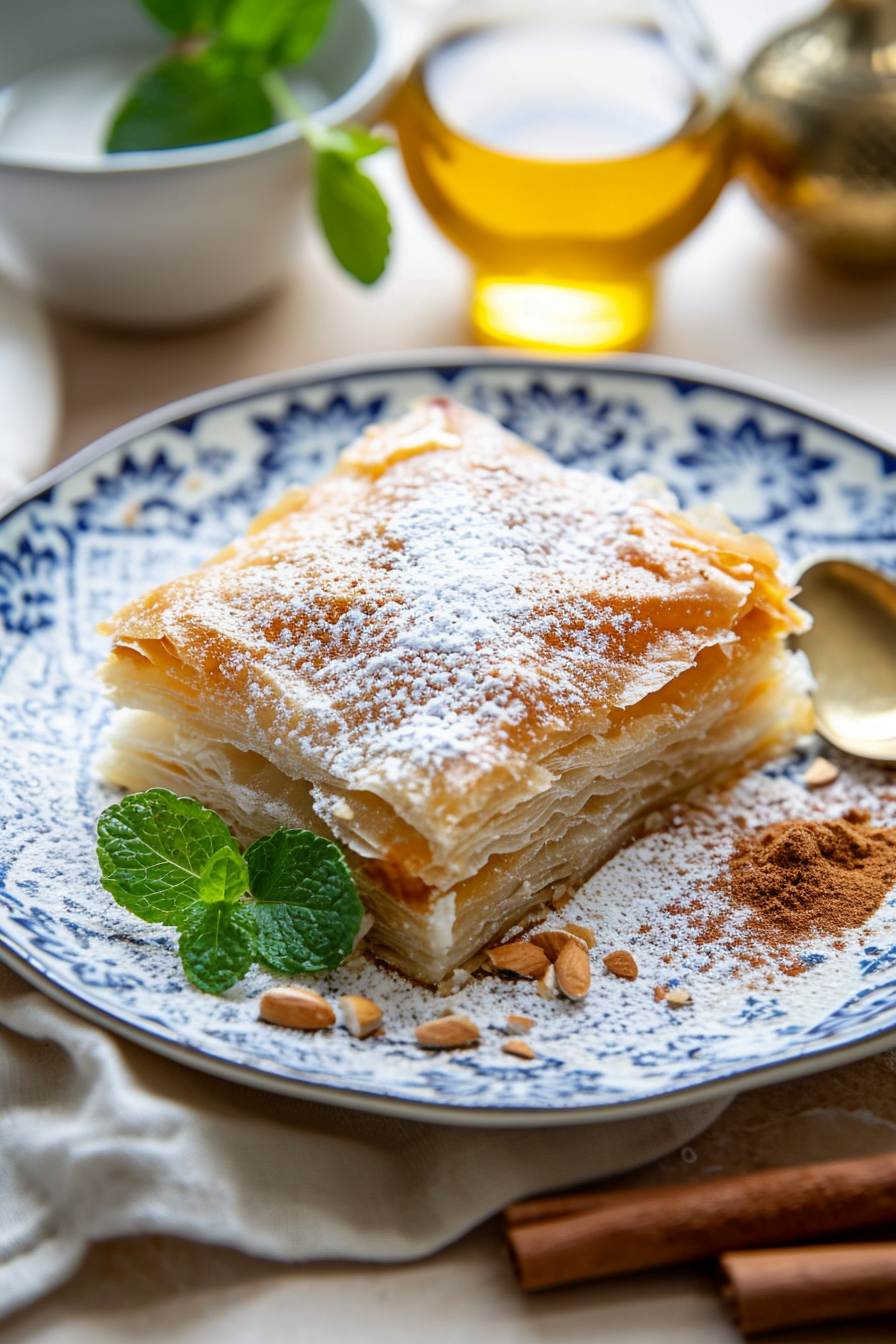
Mastering the Bisteeya Technique
Creating a Moroccan Bisteeya with Chicken and Cinnamon is an art form that involves several critical steps to ensure the perfect balance of flavors and textures. Here are some chef’s tips to elevate your Bisteeya:
Spice Infusion: The key to a flavorful Bisteeya lies in the spices. When seasoning the chicken, take the time to massage the cinnamon, ginger, and turmeric into the meat. This not only ensures an even distribution of flavors but also allows the spices to penetrate the chicken, resulting in a more aromatic and succulent filling.
Phyllo Dough Perfection: Phyllo dough can be delicate and prone to drying out. To prevent this, keep the sheets covered with a damp cloth as you work. When brushing with melted butter, use a gentle hand to avoid tearing the dough. Layering the phyllo is crucial for creating the pie’s signature flaky texture, so don’t rush this step.
Balancing Sweet and Savory: The interplay of sweet and savory is what sets the Bisteeya apart. To achieve this harmony, taste the chicken and egg mixture before adding the powdered sugar and adjust accordingly. The goal is to have a subtle sweetness that complements, rather than overpowers, the savory spices.
Baking to Golden Perfection: Monitor the Bisteeya closely as it bakes to achieve that beautiful golden-brown crust. The color is not just for aesthetics; it’s an indicator of the pastry’s crispness. If the top is browning too quickly, tent it with foil to prevent burning while allowing the rest of the pie to cook through.
Letting it Rest: Resist the temptation to cut into the Bisteeya immediately after baking. Allowing it to cool slightly will enable the filling to set, making it easier to slice and serve. The wait will be worth it when you present a pie that’s as visually appealing as it is delicious.
Remember, making Bisteeya is as much about the process as it is about the end product. Take your time, enjoy the aromas and textures, and you’ll be rewarded with a dish that’s a true reflection of Moroccan culinary artistry.
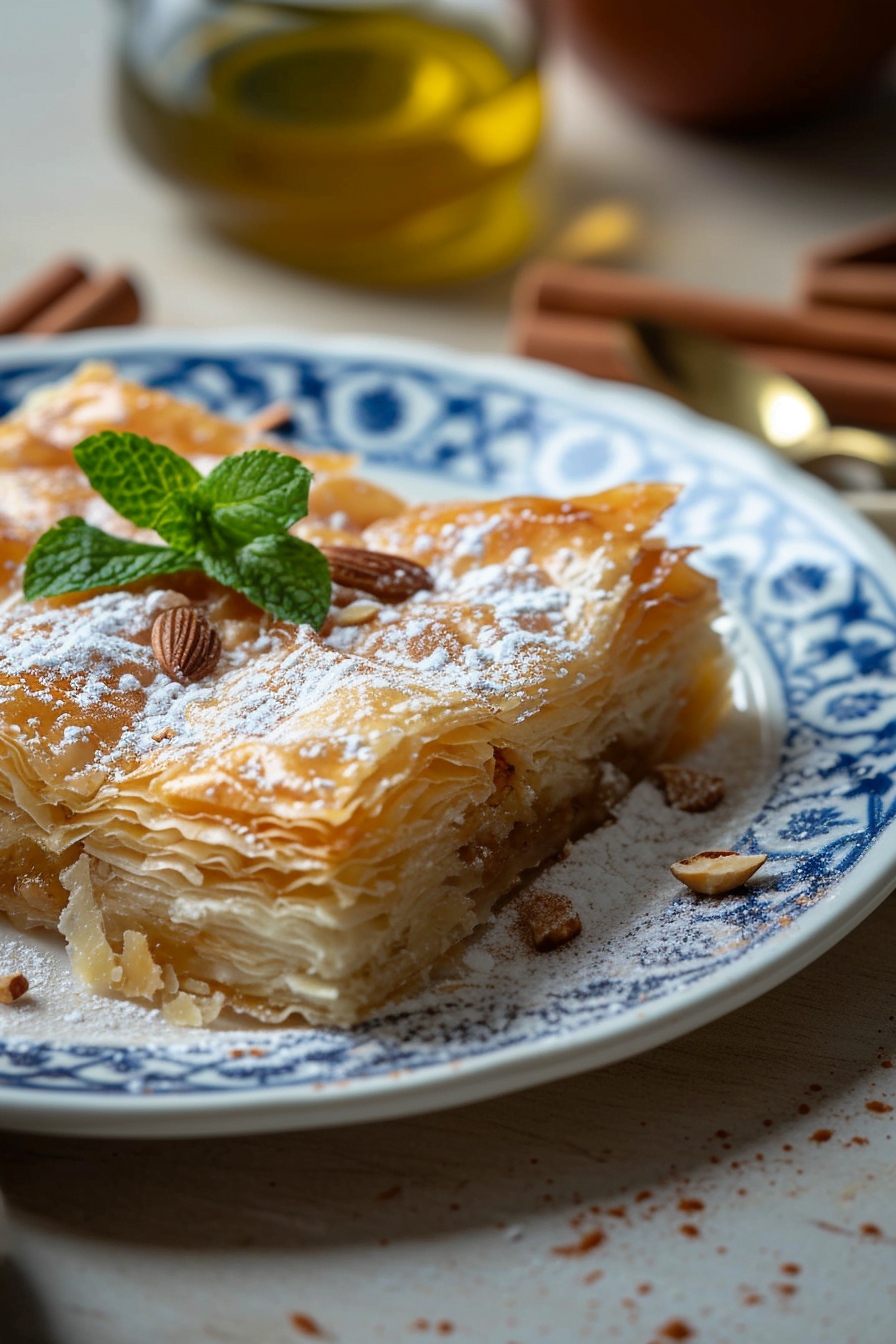
Variations to the Classic Bisteeya
Seafood Delight: For a coastal twist, replace the chicken with a mix of seafood. Imagine shrimp, calamari, and scallops, gently sautéed with garlic and a touch of saffron. This seafood version pays homage to Morocco’s Mediterranean and Atlantic coastlines, where fresh catch is a daily staple.
Vegetarian Oasis: Create a vegetarian Bisteeya by using a rich blend of roasted vegetables, such as eggplant, zucchini, and bell peppers. Add some crumbled feta cheese for creaminess and chickpeas for protein. This variation celebrates Morocco’s abundant produce and caters to those seeking a meat-free option.
Lamb and Apricot Fusion: Lamb is a beloved meat in Moroccan cuisine. For a different take on Bisteeya, use slow-cooked lamb shoulder, spiced with ras el hanout. Add chopped dried apricots for a sweet contrast. This version is a nod to the classic Moroccan tagine, where meat and fruit often dance together in harmony.
Substitutions for Bisteeya Ingredients
Phyllo for Warka: If you’re aiming for authenticity, seek out warka dough, the traditional wrapper for Bisteeya. This paper-thin Moroccan pastry can be hard to find, but it offers a slightly chewier texture and a unique taste. If unavailable, phyllo is an excellent substitute that still delivers the desired crispness.
Nuts and Sweetness: While almonds are traditional, other nuts like walnuts or pistachios can offer a different flavor profile. If powdered sugar seems too sweet, consider using honey or agave syrup for a more nuanced sweetness that complements the spices without overwhelming them.
Protein Variations: For those who do not consume chicken, consider using duck or turkey as a substitute. These meats also pair beautifully with the warm spices and offer a similar texture to the original recipe. Adjust cooking times accordingly to ensure the meat is tender and fully cooked.
Frequently Asked Questions
| Question | Answer |
|---|---|
| Can I make Bisteeya ahead of time? | Yes, you can prepare the Bisteeya in advance and refrigerate it before baking. Just be sure to bring it to room temperature before placing it in the oven to ensure even cooking. |
| Is it possible to freeze Bisteeya? | Absolutely. Bisteeya can be frozen either before or after baking. Wrap it tightly to prevent freezer burn. Thaw overnight in the refrigerator and reheat in the oven until heated through. |
| How do I prevent the phyllo from drying out? | Keep the unused phyllo sheets covered with a damp towel while assembling the Bisteeya. Work quickly and brush each layer with melted butter to keep it moist. |
| What can I use if I don’t have orange blossom water? | If orange blossom water is unavailable, rose water is a good alternative. You can also omit it entirely; the Bisteeya will still be delicious. |
| Can I use a different type of dough instead of phyllo? | While phyllo is the best substitute for traditional warka dough, in a pinch, you could use puff pastry for a different texture. Adjust baking times as needed. |
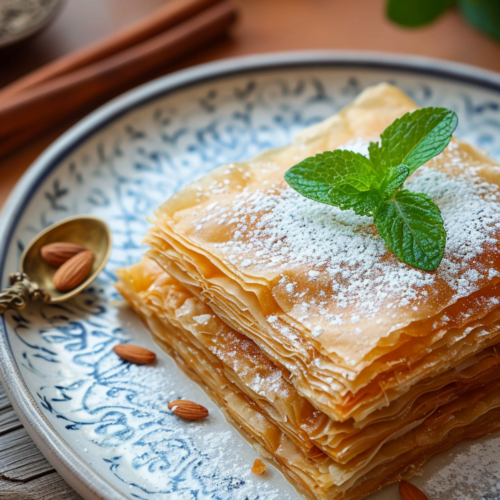
Moroccan Bisteeya with Chicken and Cinnamon
Equipment
- Large skillet
- Baking sheet
- Pastry brush
Ingredients
- 1 lb skinless, boneless chicken thighs
- 1 tsp ground cinnamon
- 1 tsp ground ginger
- 1/2 tsp turmeric
- Salt and black pepper to taste
- 2 tbsp olive oil
- 1 large onion, finely chopped
- 3 large eggs
- 1/4 cup chicken broth
- 1/2 cup roasted almonds, chopped
- 1/4 cup powdered sugar, plus extra for dusting
- 6 sheets phyllo dough
- 4 tbsp unsalted butter, melted
- 2 tbsp orange blossom water optional
Instructions
- Preheat your oven to 375°F (190°C).
- Season the chicken thighs with cinnamon, ginger, turmeric, salt, and pepper.
- Heat olive oil in a large skillet over medium heat. Add the seasoned chicken and brown on all sides, then add chopped onion and cook until translucent.
- Pour in chicken broth, cover, and let simmer for 20 minutes, or until the chicken is cooked through.
- Remove the chicken, shred it, and set aside. Beat the eggs and pour them into the skillet with the onion and broth mixture, cooking until they are scrambled and set.
- Combine the shredded chicken, scrambled eggs, almonds, powdered sugar, and orange blossom water in a bowl, mixing well.
- Lay out a sheet of phyllo dough on a clean surface, brush with melted butter, and place another sheet on top. Repeat this process until all sheets are used.
- Place the chicken mixture in the center of the stacked phyllo sheets, and fold the dough over the filling to create a parcel, sealing the edges with butter.
- Place the parcel on a baking sheet with the seam side down, brush the top with more melted butter, and bake for 25-30 minutes, or until golden brown.
- Let the Bisteeya cool slightly, then dust with powdered sugar before serving.
Notes

